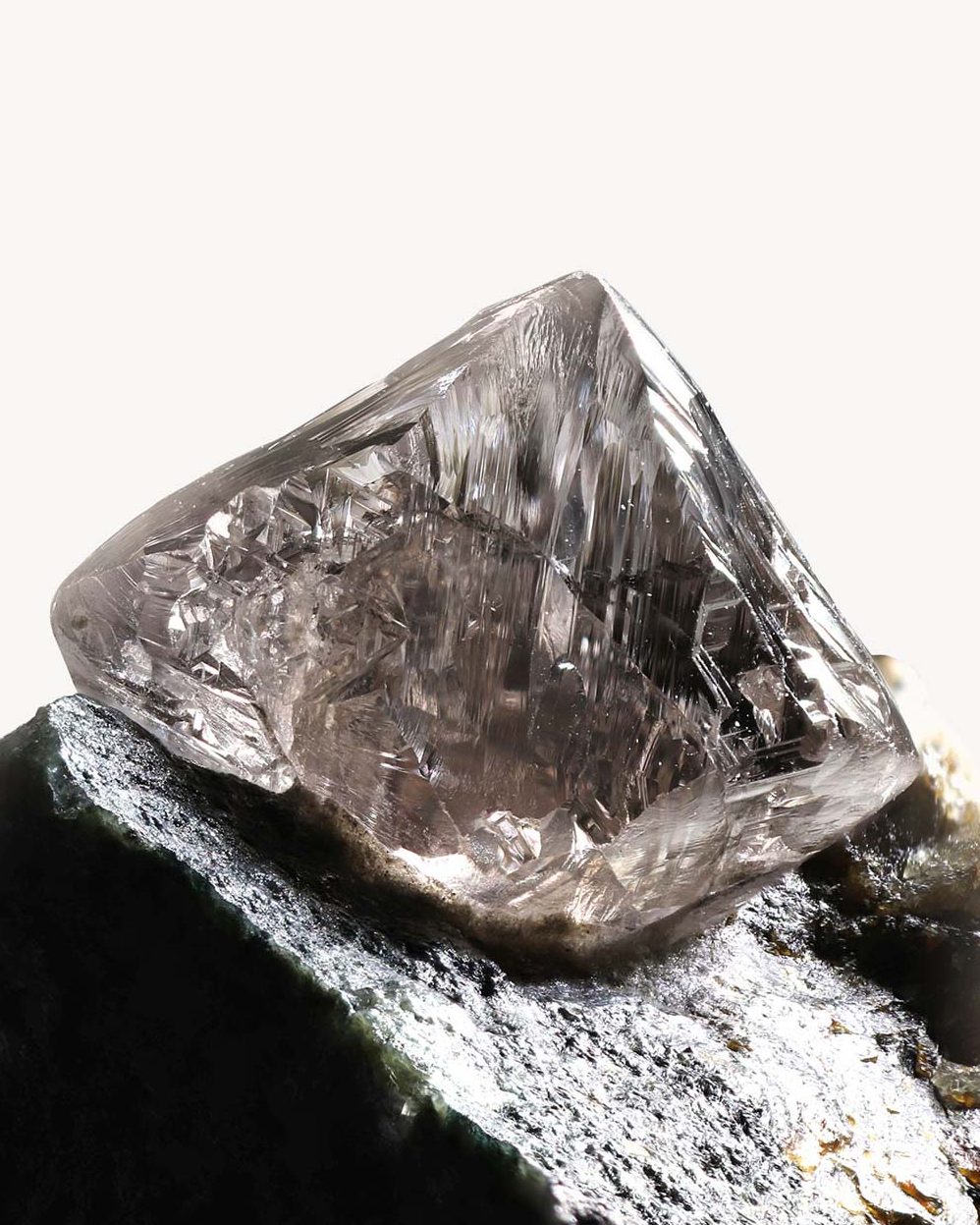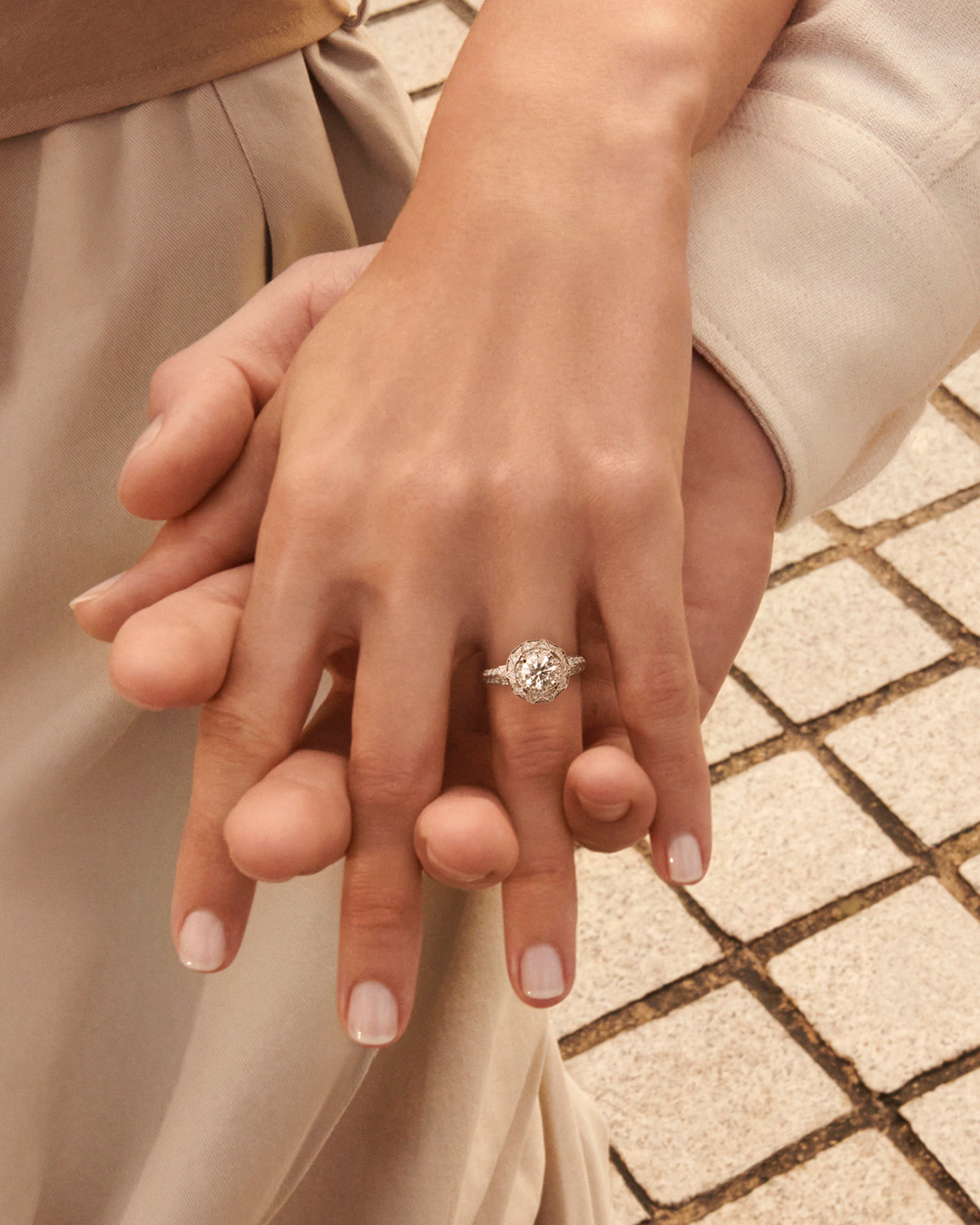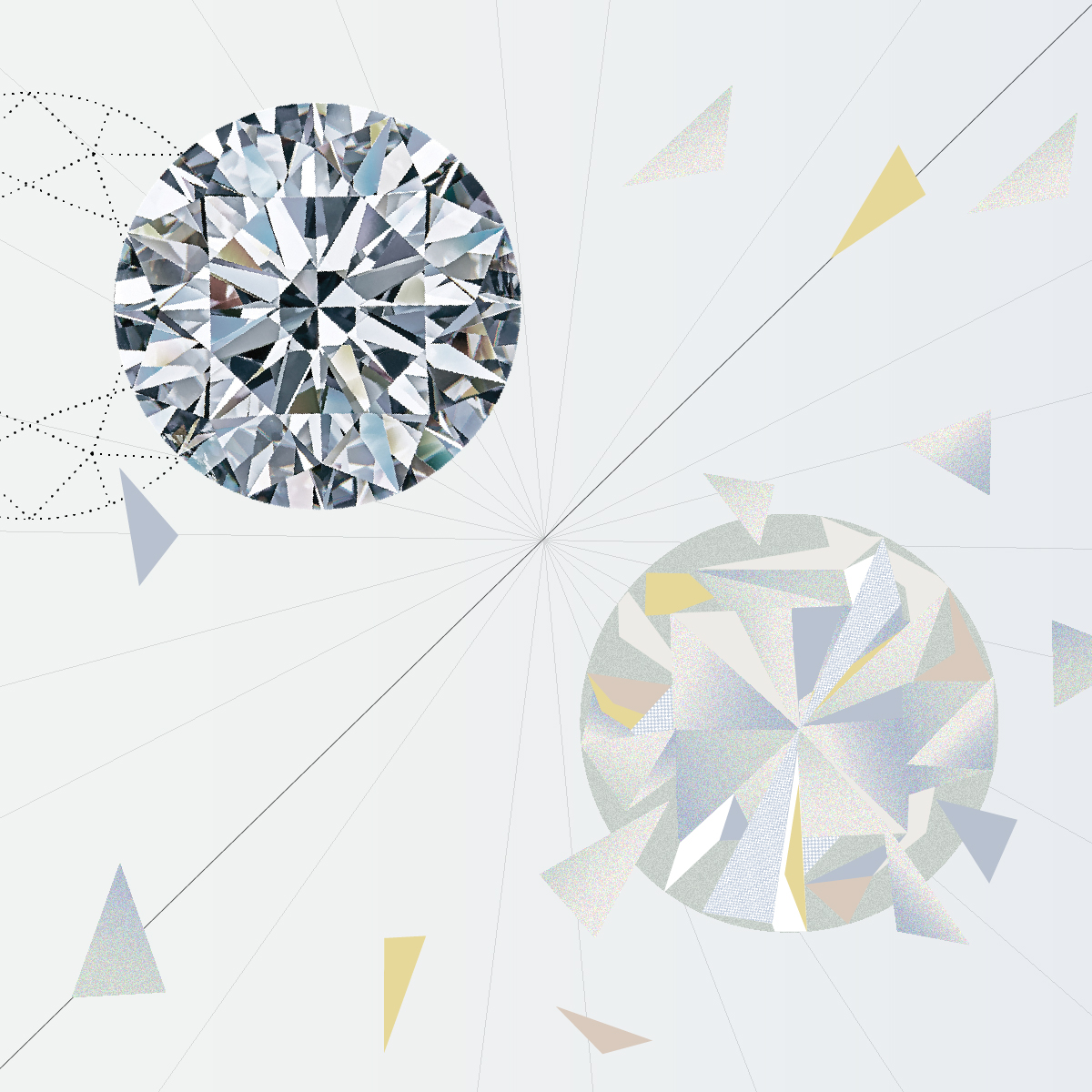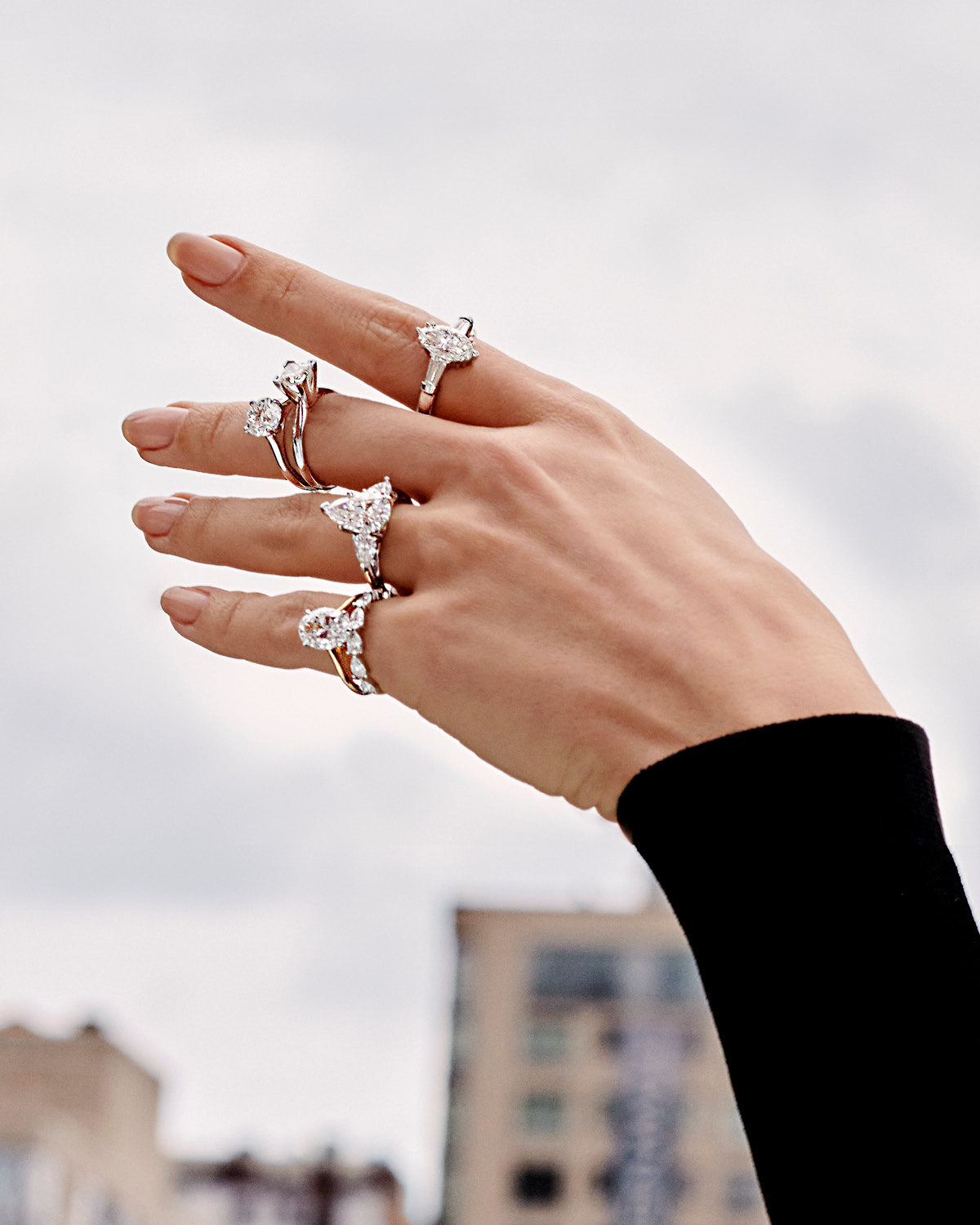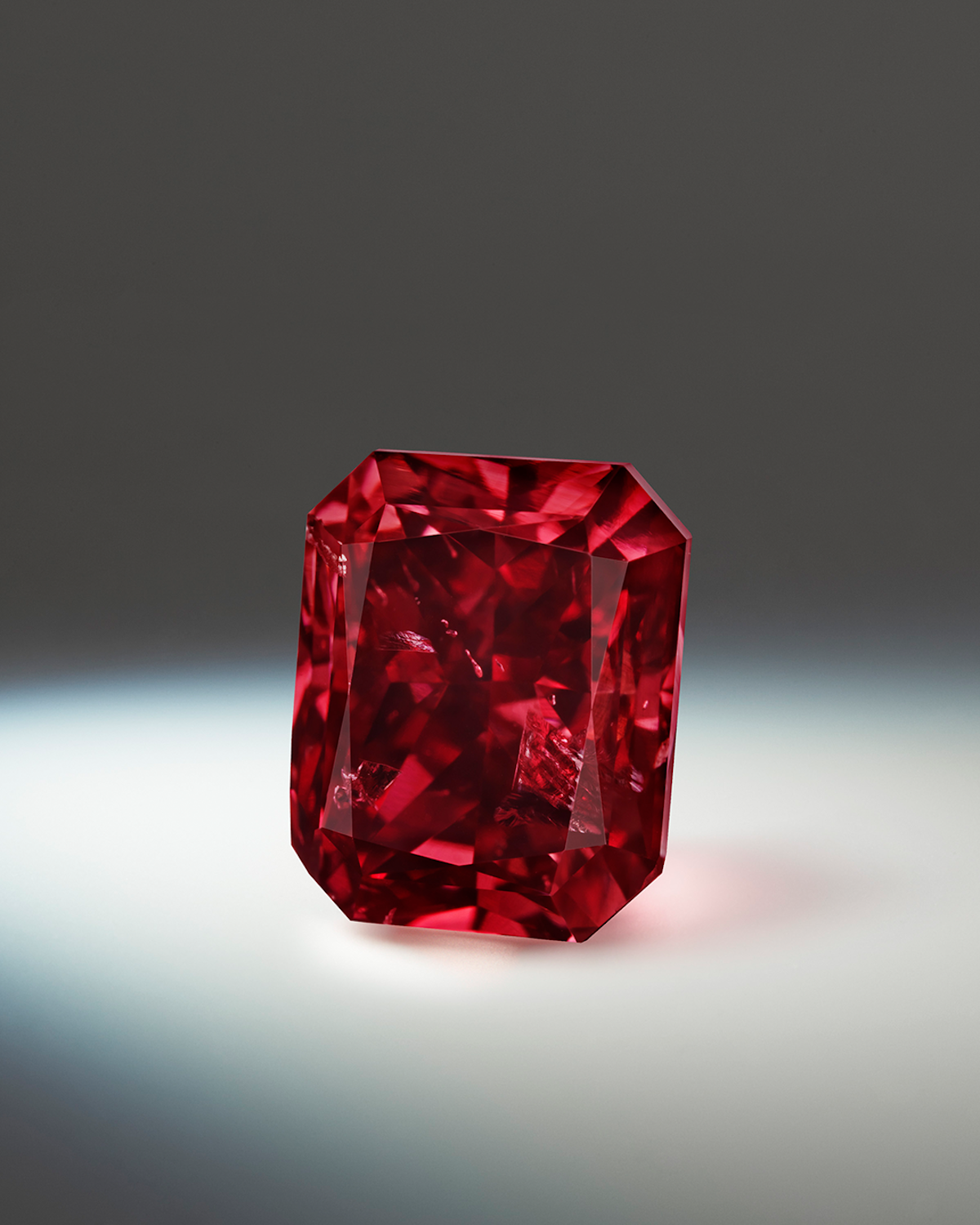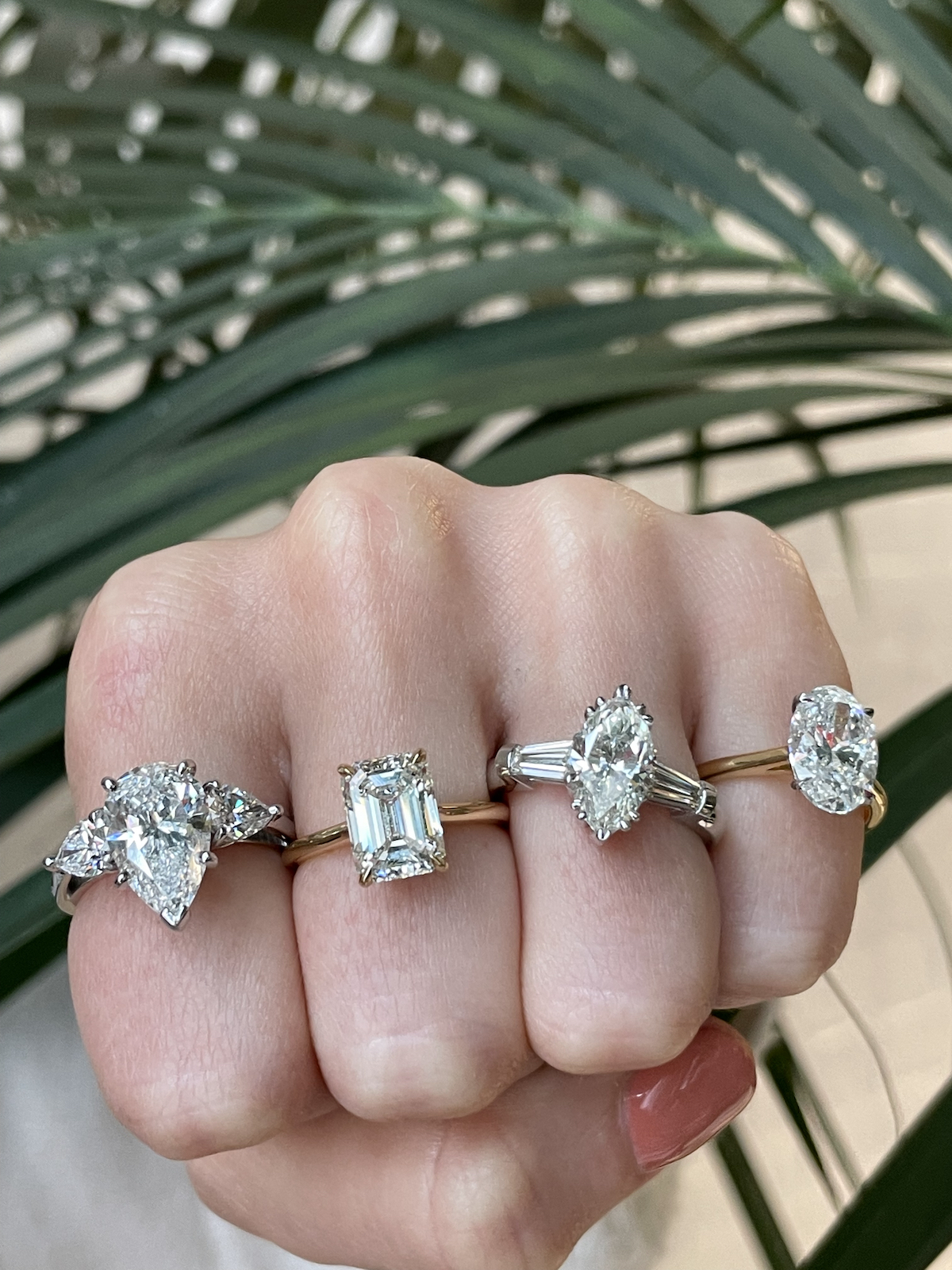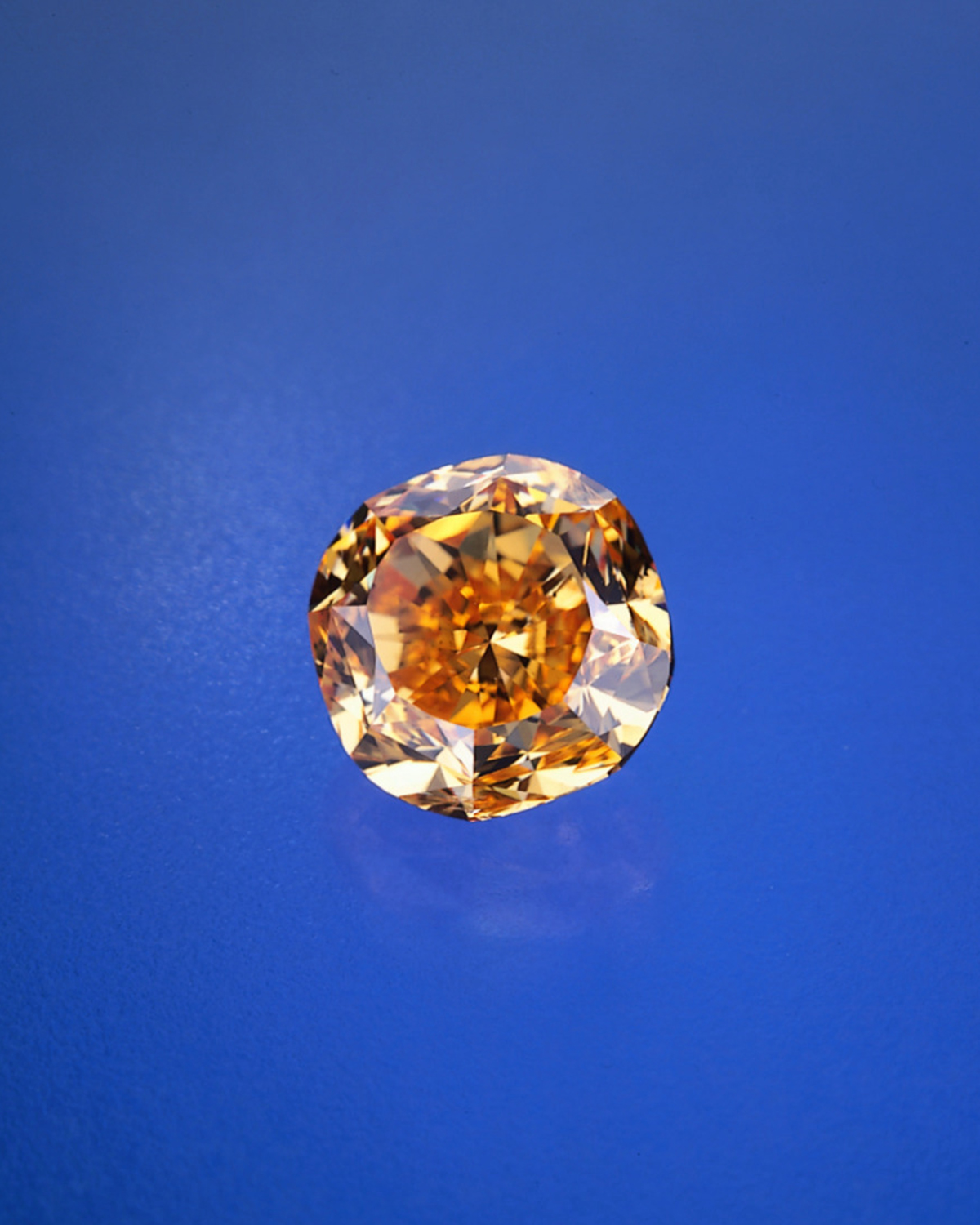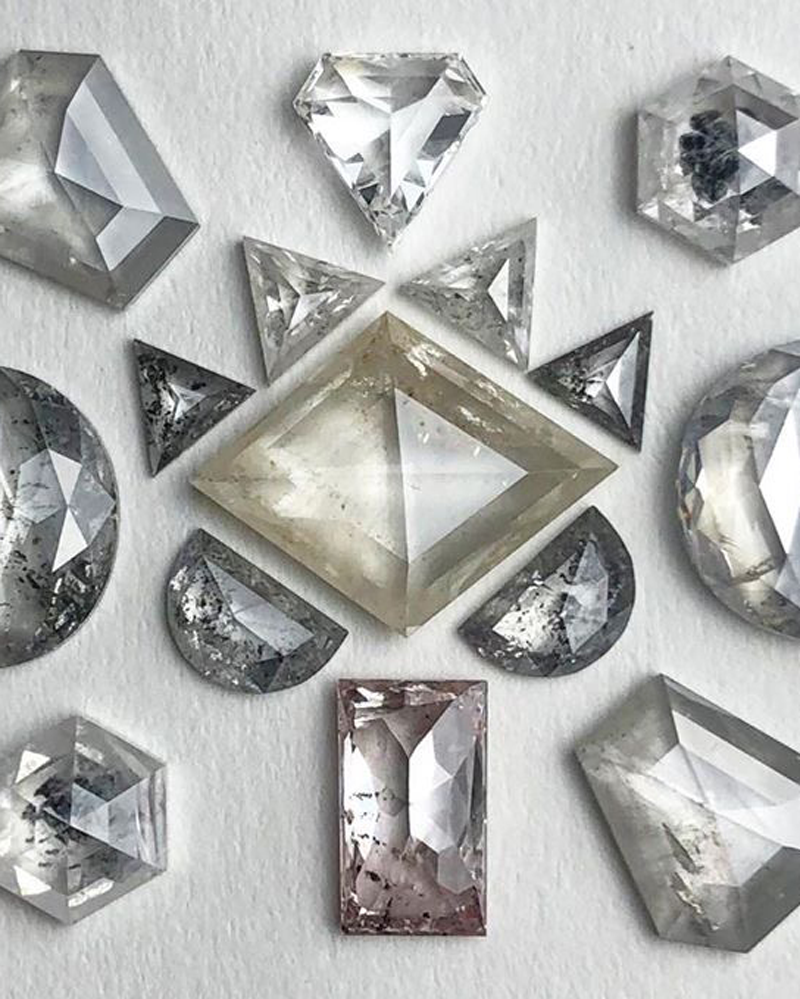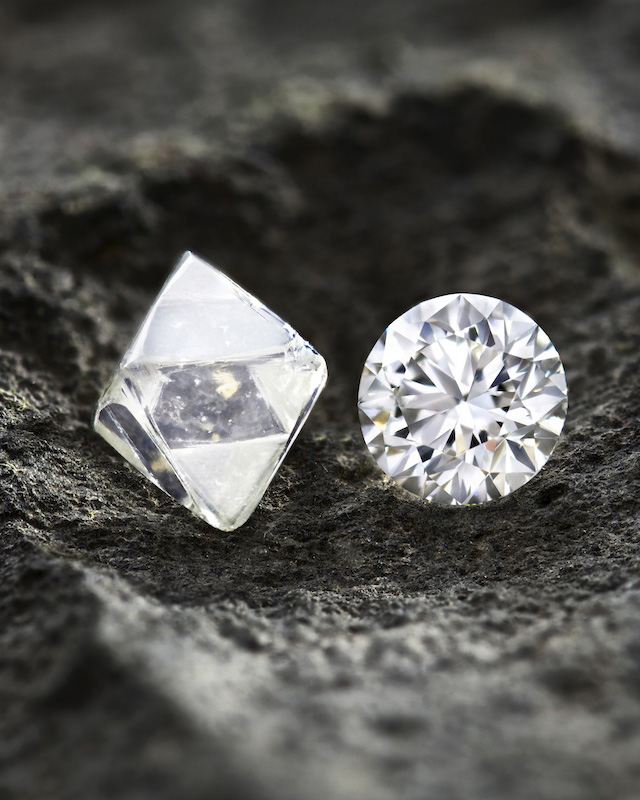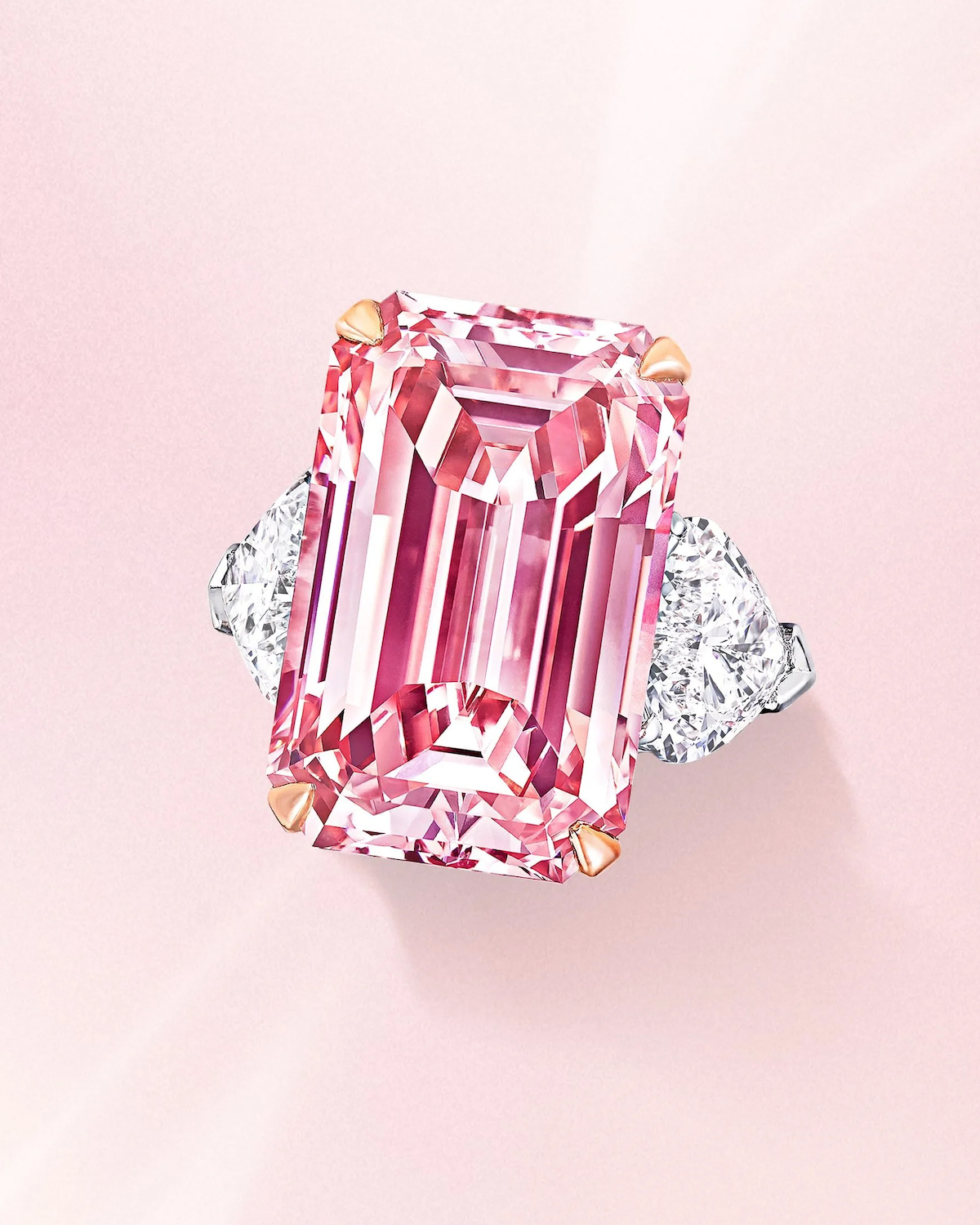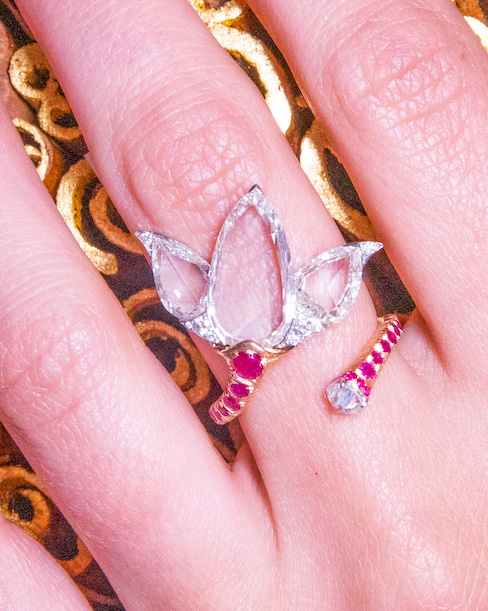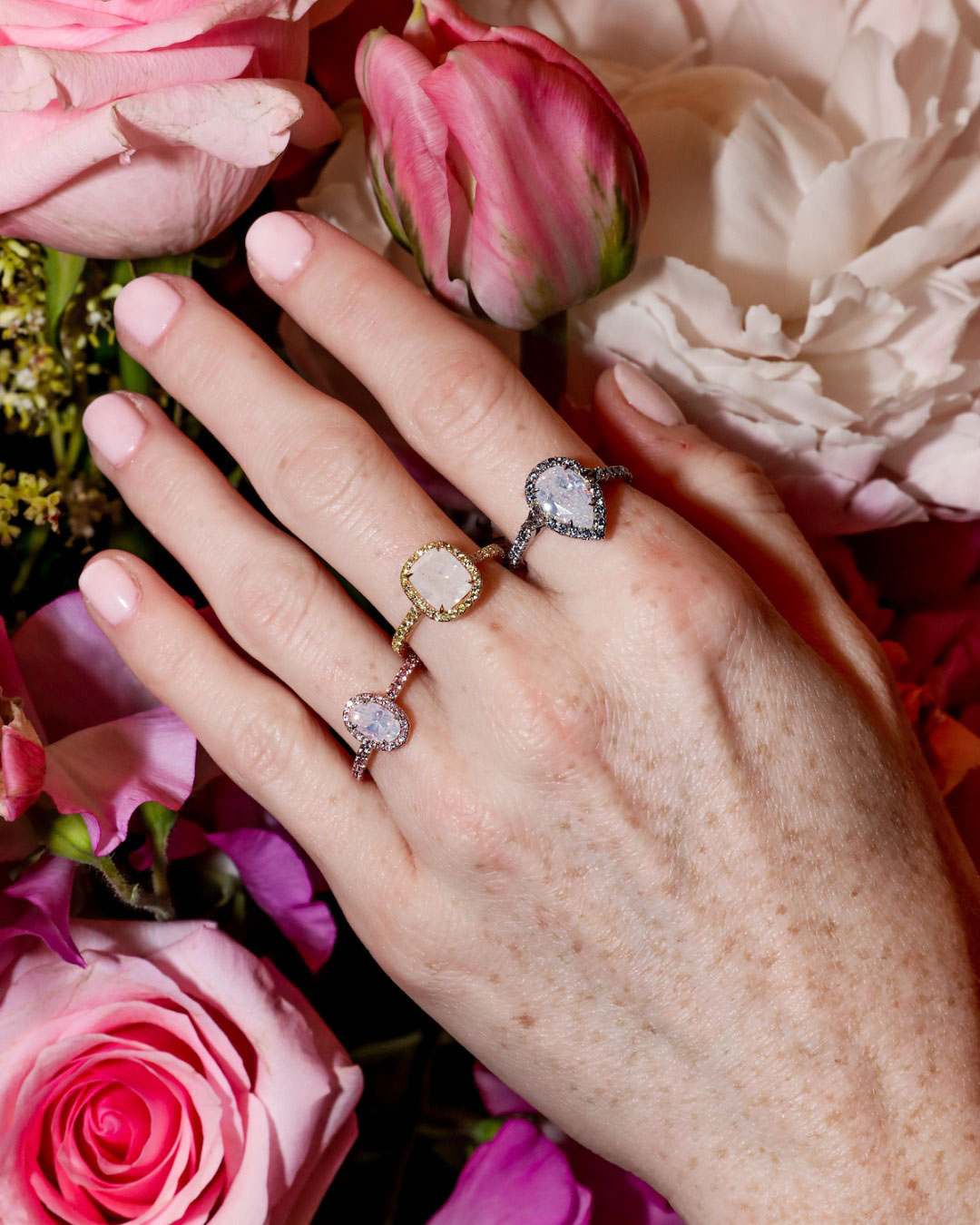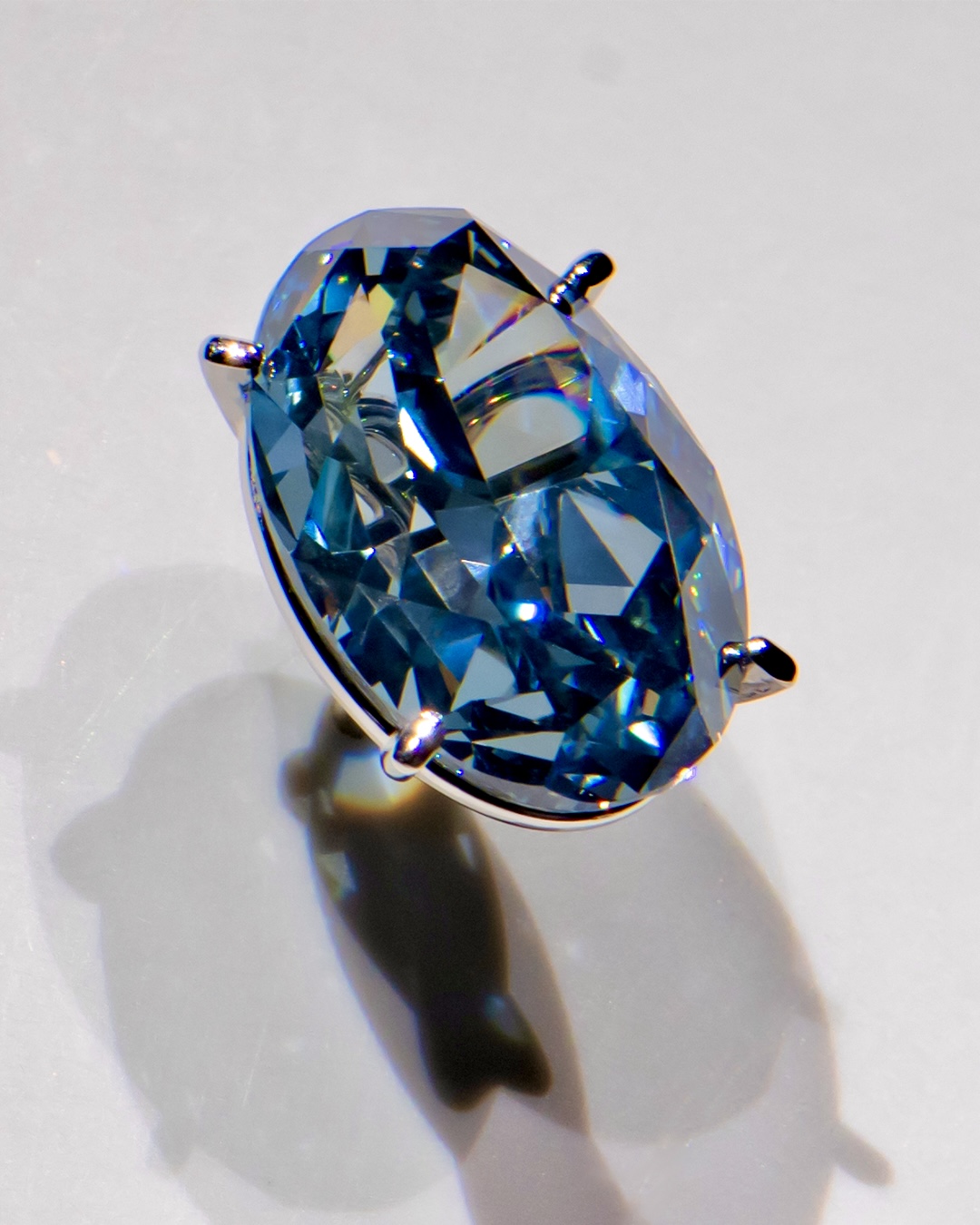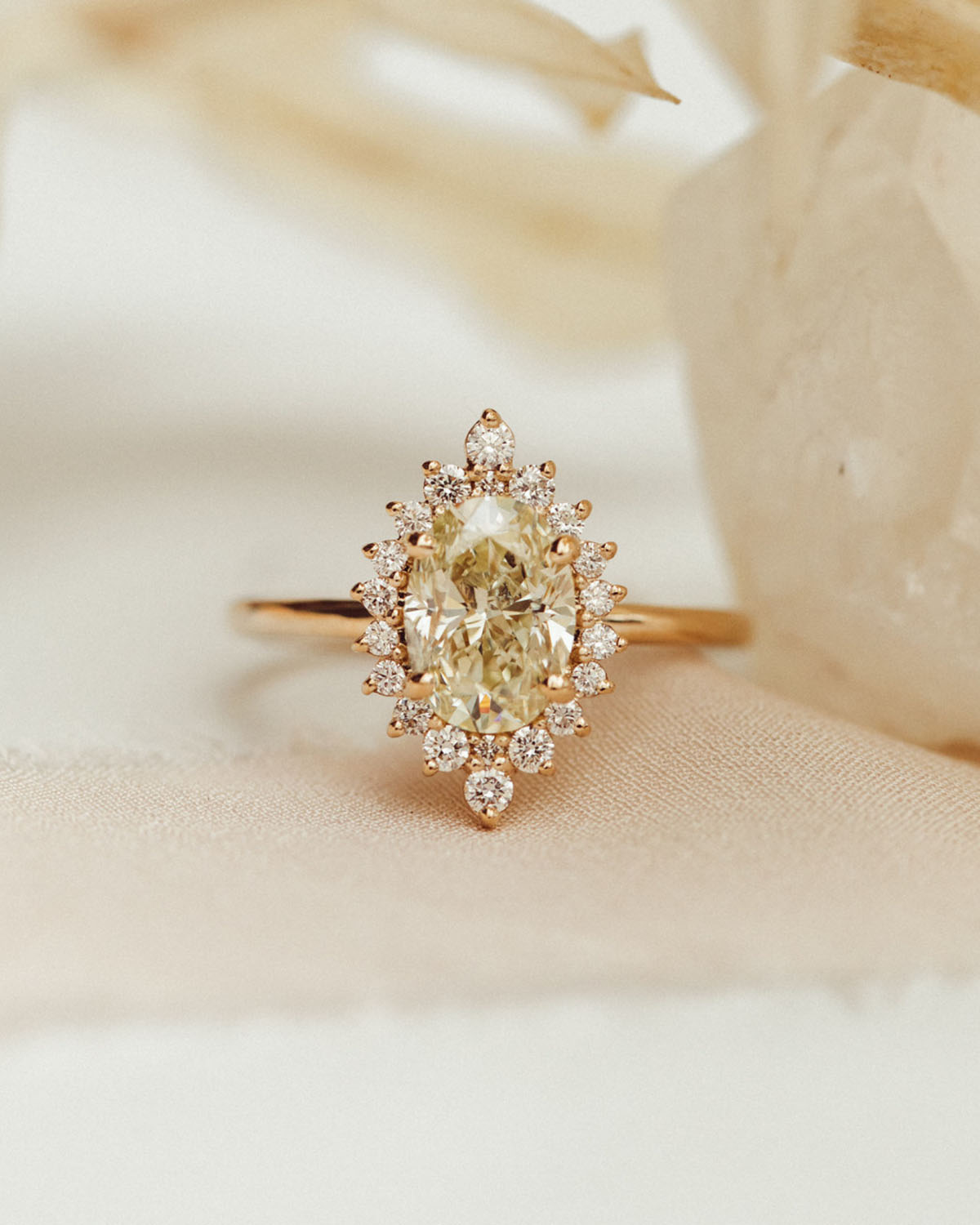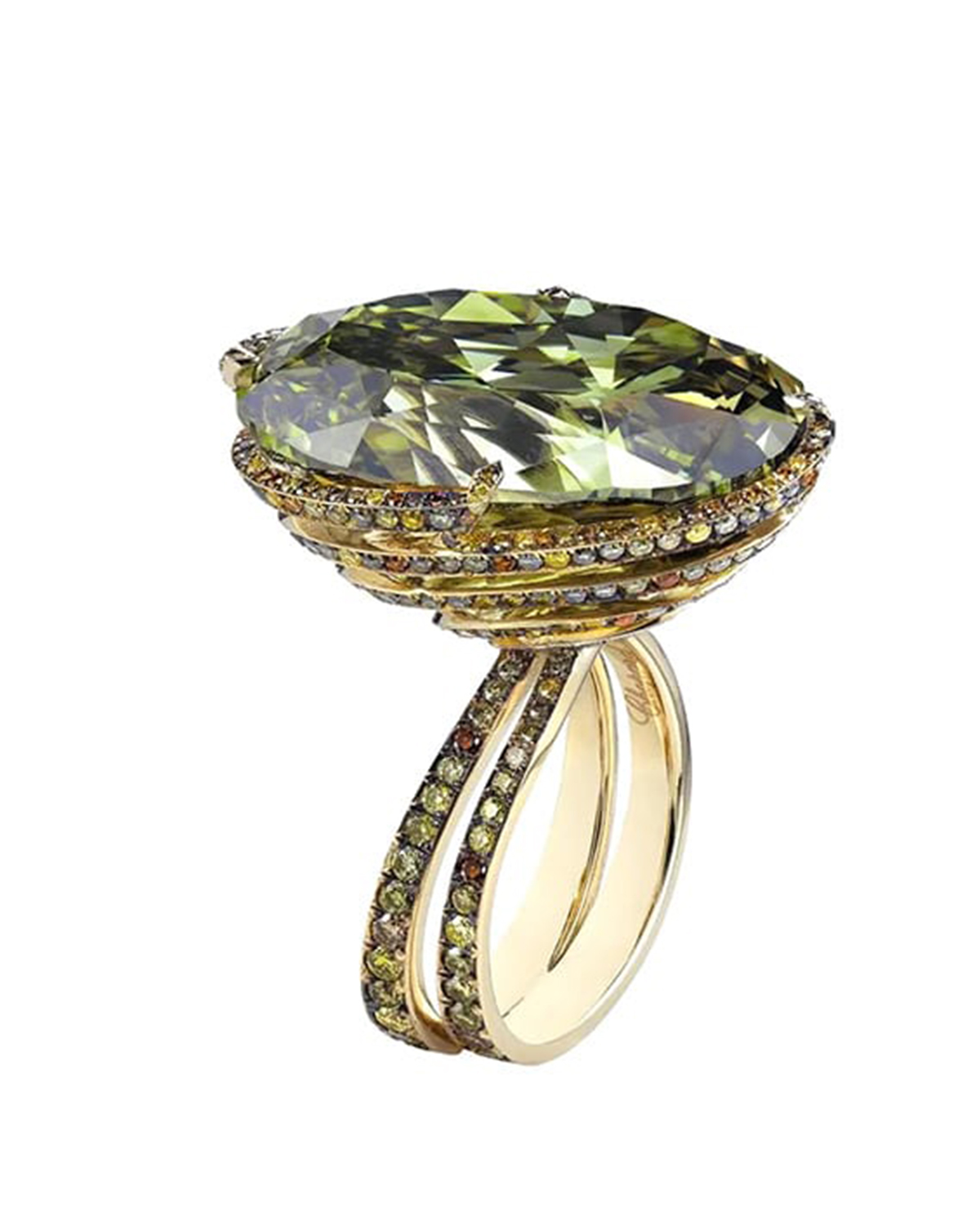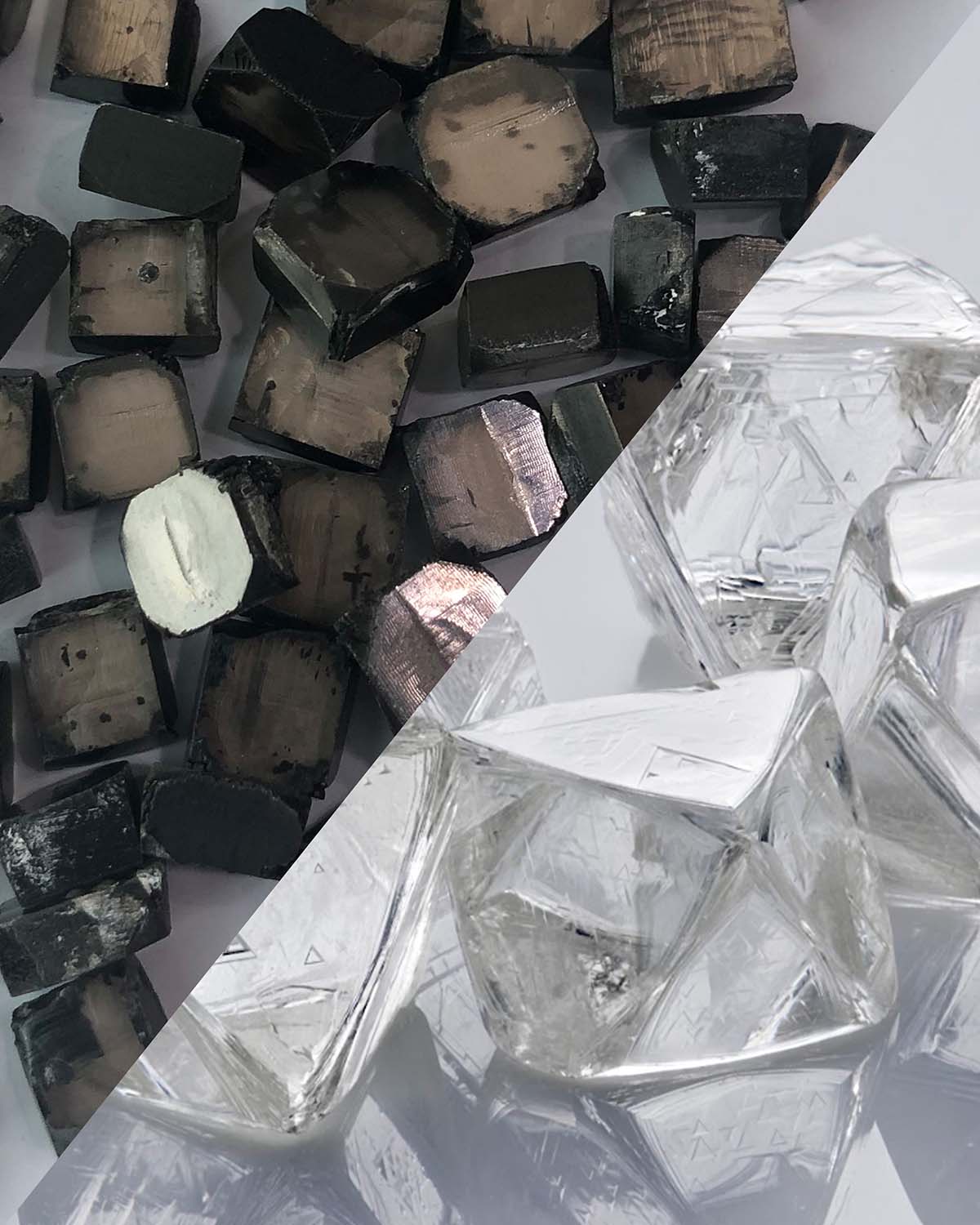
Diamond FAQs
Our diamond FAQs dispel some of the myths around natural diamonds: their rarity, environmental impact and value.
What Is A Natural Diamond?
A natural diamond is a rare and finite mineral formed by nature, consisting of a crystalline structure of pure carbon atoms. Known for being the hardest naturally occurring substance on Earth, natural diamonds are celebrated for their incredible durability, brilliance, and exceptional rarity. Unlike lab-grown diamonds, which are man-made, a natural diamond refers specifically to a gemstone formed deep within the Earth over billions of years through extremely high temperature and high pressure. When shopping for diamonds or diamond jewelry, it’s important to note the word “diamond” used alone always means a natural diamond and not a lab-grown diamond or diamond simulant.
Most natural diamonds range in age from one to three billion years, with some rare specimens being over 3.5 billion years old, making them older than humans and dinosaurs.
Natural diamonds are widely used in fine jewelry, especially in diamond engagement rings, and are known for their timeless beauty and value. Their unique formation process makes each natural diamond distinct and irreplaceable.
What Is The Actual Value of Natural Diamonds?
Like other natural materials, how much natural diamonds cost is based on how rare they are to find in nature. The rarer the natural diamond, the more valuable it will be. Over the last 35 years, natural diamond prices have been shown to appreciate by approximately 3% annually. In its 2019 Global Diamond Industry Report, Bain & Co. found that the diamond market has grown thrice over the past 50 years.
How old are diamonds?Most natural diamonds are between 1 and 3 billion years old. Diamonds form deep within the Earth under intensely high temperatures and pressure, causing carbon atoms to crystallize before being transported to the Earth’s surface by powerful volcanic eruptions, such as kimberlite and lamproite eruptions. Although diamond formation occurs far beneath the Earth’s surface, these eruptions are rare yet immensely powerful, carrying diamonds from the Earth’s mantle to locations where they can be recovered.
These rare and precious gemstones are likely the oldest things you will ever touch, having formed long before any life existed on Earth. The oldest diamonds that have been dated, found in Canada, are 3.7 billion years old.
What Is The Environmental Impact of Natural Diamonds?
The carbon footprint of a 1-carat natural diamond from mine to finger is approximately the same as making one Macbook computer. In large-scale natural diamond mining operations, three acres are conserved for every acre of land used, protecting around 1,000 square miles of ecosystems, wildlife, and endangered species in Australia, Botswana, Canada, South Africa, and Tanzania. The diamond mining industry is making strong strides in carbon emissions reduction to achieve carbon neutrality to combat climate change, utilizing eco-friendly, renewable energy sources such as wind farms and hydropower and pioneering carbon capture technology with kimberlite rock (the source of diamonds) naturally absorbing and storing CO2. Leading natural diamond mining companies recycle 84% of water usage in the mining process and 99% of the waste produced is rock. There are no toxic chemical bi-products from natural diamond mining because once diamonds are removed from the ground, they are easily extracted from the host rock.
Why Is It More Accurate To Refer To Natural Diamonds as Natural Instead of Mined?
The terms “mined diamonds” or “earth-mined diamonds” can be confusing and potentially misleading. Not all natural diamonds are actually mined. Some diamonds remain locked deep within the Earth, unreachable by current mining technology, while others are pushed to the Earth’s surface by natural forces such as volcanic eruptions and recovered without traditional diamond mining processes.
For jewelers and consumers alike, it’s important to understand that the term “natural” more accurately describes a diamond’s true origin, regardless of how it is recovered. According to the Federal Trade Commission’s Jewelry Guides, terms such as “real,” “natural,” “genuine,” and “precious” are specifically reserved for diamonds that have naturally formed in the Earth, whether or not they are extracted through mining.
Using “natural diamond” instead of “mined diamond” helps avoid confusion and ensures that the true nature of these precious stones is accurately represented within the diamond industry.
Aren’t Diamonds Just A Product Of Good Marketing?
Human fascination with diamonds goes back millennia, long before diamond marketing existed. It is said that the tips of Cupid’s arrow were dipped in diamonds. Archduke Maximilian of Austria gave the first diamond engagement ring on record in the imperial court of Vienna in 1477. And let’s not forget the great American classic, Gone With the Wind, which featured a diamond engagement ring two decades before the famous slogan ‘A Diamond Is Forever’ was coined.
Is The Diamond Industry A Monopoly?
No. There is no monopoly in today’s diamond market. Spread across four continents, today’s largest diamond producers are located in Canada, Africa, Siberia, and Australia, and they are either publicly traded corporations or state-owned enterprises. Today, no company has a majority market share of diamond production, which means there is no possibility of stockpiling or artificial pricing.
Are Diamonds Rare?
Yes. Natural diamonds are a finite and rare natural material among Earth’s top 10 rarest natural materials. The number of newly recovered diamonds peaked in 2005, so fewer and fewer diamonds have been found every year since. Over the last 140 years, almost 7,000 kimberlite pipes have been analyzed by geologists, yet approximately only 60 of these were deemed suitable for rough diamond recovery. The annual recovery of all natural diamonds 1-carat and above can fill just 1 exercise ball.
Colored diamonds, called fancy color diamonds, are even rarer, due to the unique geological processes that form them. The rarest hues, such as blue diamonds and red diamonds, can sell for over $1 million per carat due to their exceptional rarity.
Are Colored Diamonds Real?
Yes, natural colored diamonds can be real, but not always. Natural diamonds can form in nearly every color of the rainbow and these rare gemstones, known as Fancy Color Diamonds, are exceptionally valuable. Unlike traditional colorless diamonds, evaluated based on GIA’s color grading scale from D to Z, Fancy Color Diamonds are evaluated based on tone, hue, and saturation. This includes all colors other than colorless diamonds to light yellow diamonds or brown diamonds. The rarest hues, such as blue and red diamonds, can sell for over $1 million per carat due to their exceptional rarity.
The natural colors of diamonds result from unique geological processes. For instance, blue diamonds owe their color to boron atoms trapped during formation, while green diamonds are colored by exposure to natural radiation deep within the Earth. Black diamonds, though not as “colorful” in the traditional sense, are considered a fancy color because their deep, opaque appearance sets them apart from standard colorless diamonds. Their dark, sometimes jet-black, appearance is due to the presence of inclusions and fractures within the diamond, which absorb light rather than refracting it.
However, not all colored diamonds are natural. Some are treated to mimic these hues, and while they may appear similar, they don’t hold the same value. Similarly, lab-grown diamonds can be made in various colors but lack the rarity and intrinsic value of natural Fancy Color diamonds. To confirm a diamond’s authenticity and natural origin, always request an independent grading certificate that verifies its natural status and color origin.
Is Diamond Mining Dangerous To People?
No, modern diamond mining is not inherently dangerous to people. In fact, reputable diamond mining operations prioritize the safety and well-being of their employees. These companies implement strict safety protocols and invest heavily in creating safe working conditions. As a result, diamond mining provides high-quality, high-paying career opportunities in remote regions where job options are limited.
Leading diamond producers put the health and safety of their workers first, with many offering competitive wages. Employees of top diamond mining companies earn, on average, 64% more than the national average salary, and in many cases, they receive nearly five times the living wage in their country. These positive economic impacts demonstrate that the modern diamond mining industry not only ensures safety and respects human rights, but also helps improve the livelihoods of local communities.
Do Laboratory-Grown Diamonds Come With Grading Reports?
While some diamond grading laboratories do not certify laboratory-grown diamonds, reputable organizations such as the Gemological Institute of America (GIA), the International Gemological Institute (IGI), and the Gemological Science International (GSI) provide detailed grading reports for lab-grown diamonds. These reports clearly indicate that the diamond is laboratory-grown, not natural. It’s crucial to be cautious of non-third-party grading reports that may fail to clearly disclose a diamond as lab-grown.
Are Laboratory-Grown Diamonds More Socially Conscious Than Natural Diamonds?
No. The natural diamond industry supports the livelihoods of 10 million people worldwide, with leading diamond producers generating $16 billion in benefits annually for employees, communities, and the environment. Notably, 80% of these benefits are retained by local communities, fostering long-term economic growth and sustainability. In contrast, the wealth created by lab-grown diamond companies primarily benefits a select group of venture capitalists and investors. These companies have yet to demonstrate the same level of socioeconomic contributions to local economies or communities, highlighting the significant difference between the economic impact of natural diamonds and synthetic diamonds.
What Is The Environmental Impact of Laboratory-Grown Diamonds?
Not all lab-grown diamonds measure up to sustainability claims, as their production involves a significant environmental footprint, including high carbon emissions, energy consumption, and water usage. To create lab-grown diamonds, manufacturers replicate the extreme conditions found deep within the Earth which form natural diamonds, using two main methods: High Pressure High Temperature (HPHT) and Chemical Vapor Deposition (CVD). Both processes require immense electricity to generate temperatures between 1,500°C (2,700°F) and pressures of 1.5 million pounds per square inch. The energy consumption required for these conditions results in a considerable carbon footprint, especially in regions like China and India, where coal is still the primary energy source. Some facilities use hydropower as a cleaner alternative, but this is still limited in many areas. Additionally, the production of lab-grown diamonds requires large amounts of water to cool the reactors, further contributing to concerns about water usage in regions with limited water resources.
Are Lab-Grown Diamonds Unique?
Laboratory-grown diamonds, often referred to as lab-created diamonds, are not unique. These man-made diamonds are produced in controlled environments, allowing for large-scale production in unlimited quantities. Typically, they are created using two methods: High Pressure High Temperature (HPHT) and Chemical Vapor Deposition (CVD). These techniques replicate the natural processes that form natural diamonds deep within the Earth, but in a much shorter time frame.
Lab-grown diamonds are manufactured to the exact specifications set by the producing company. While they share the same chemical composition and physical properties as natural diamonds, natural diamonds result from a truly incomparable journey. No two natural diamonds are alike, each one carrying its own history and story.
What Is The Difference Between Lab-Grown Diamonds And Natural Diamonds?
Laboratory-grown diamonds are not identical to natural diamonds, despite their similar appearance. Lab-grown diamonds are mass-produced in factories, primarily located in China, India, and Singapore, using methods like Chemical Vapor Deposition (CVD) or High Pressure High Temperature (HPHT). The rapid, artificial production process results in distinct chemical compositions and growth patterns that differ from those of natural diamonds. These unique characteristics make lab-grown diamonds easily detectable by experts or with specialized equipment. While they may look almost identical to natural diamonds to the naked eye, their internal structure and formation process are not the same.
Do Lab-Grown Diamonds Hold Value?
Lab-grown diamond prices have dropped significantly, from 80% of the cost of natural diamonds in 2016 to less than 20% by 2024. This dramatic price reduction is largely due to the ability to produce lab-grown diamonds in unlimited quantities using methods like Chemical Vapor Deposition (CVD) and High Pressure High Temperature (HPHT). Unlike natural diamonds, which are rare, lab-grown diamonds are priced based on production costs and retail markup. As production techniques improve and scale, their value is expected to continue declining until they reach a stable price point.
What Is A Lab-Grown Diamond?
A laboratory-grown diamond, also known as a synthetic diamond, lab-created diamond, or man-made diamond, is a man-made gemstone that mimics the physical properties and optical properties of a natural diamond. Unlike natural diamonds, lab-grown diamonds can be produced in unlimited quantities. Lab-grown diamonds are created using advanced technologies such as High Pressure High Temperature (HPHT) or Chemical Vapor Deposition (CVD), which simulate the conditions under which natural diamonds form deep within the Earth’s mantle.
Why Are Natural Diamonds More Expensive Than Lab-Grown Diamonds? Are They Worth It?
Natural diamonds cost more due to their rarity and the complex geological processes that form them. These gemstones, especially larger diamonds with exceptional color and clarity, are incredibly rare. They are created over billions of years under extremely high pressure and temperature deep within the Earth’s crust. This scarcity makes natural diamonds highly valuable in the diamond market and determines the price difference between lab-grown and natural diamonds.
On the other hand, lab-grown diamonds (also known as synthetic diamonds, lab-created diamonds or man-made diamonds) can be produced in virtually unlimited quantities, through Chemical Vapor Deposition (CVD) or High Pressure High Temperature (HPHT)processes. With modern technology, lab diamonds can be created in any carat weight, color grade, or clarity grade, making them more affordable than natural stones. The price of lab-grown diamonds is primarily determined by production costs and profit margins, rather than rarity.
When comparing the two types of diamonds on the market, there is also a difference in diamond price trends over time. Unlike natural diamonds, which are a finite resource, lab-grown diamonds do not appreciate in value over time. In fact, as production processes become more efficient and competition increases, the value of lab-grown diamonds tends to decrease. Historically, natural diamonds have shown an average annual appreciation of about 3%, making them a stable, long-term investment with resale value.
For those seeking a truly unique, rare, and enduring diamond engagement ring or piece of jewelry, natural diamonds are an exceptional choice. They not only hold their value but also symbolize a timeless connection to the Earth’s history and natural beauty.
What Determines The Price Of A Diamond?
The value of a diamond is primarily determined by its rarity, which is reflected in the 4Cs of diamond grading, the four benchmarks that determine a diamond’s value, developed by gemologist at the Gemological Institute of America (GIA):
- Carat Weight: Larger diamonds are rarer and exponentially more valuable. The more carat increases,
- Clarity: Diamond clarity refers to the presence of internal characteristics (called inclusions) and external features (called blemishes) in a diamond. Diamonds with a clarity grade closer to flawless are rarer and more valuable. For example, a 1-carat natural diamond with G color and SI2 clarity might cost $4,000, but the price can more than double to $8,000 if flawless.
- Color: Colorless diamonds are more expensive. The closer a diamond is to D color grade (completely colorless), the rarer and more valuable it becomes. Upgrading the color of a 1-carat diamond from G to D could raise its price from $4,000 to $6,000.
- Cut: While an excellent cut grade has less impact on price than the other 3Cs, round brilliant cut diamonds tend to cost more due to the larger rough needed to create them. Unique or difficult diamond shapes/cuts may also command a higher price.
Fancy Color Diamonds are even rarer, with a 1-carat pink diamond costing over $100,000 due to their exceptional scarcity.
Diamond Fluorescence: Fluorescence in diamonds refers to the way a diamond reacts under ultraviolet (UV) light, emitting a soft glow, typically blue. While not visible to the naked eye, diamonds with strong fluorescence are generally priced lower than diamonds with no fluorescence, especially if the fluorescence causes a noticeable milky or hazy effect.
Natural vs. Lab-Grown Diamonds:
Natural diamonds are finite and rare, which drives their value. Over the last 35 years, natural diamond prices have appreciated by approximately 3% each year. In contrast, lab-grown diamonds can be produced in unlimited quantities and are priced based on production costs, not rarity.
Understanding these factors can help you better understand the diamond market and choose a diamond that reflects your preferences and budget.
Do Young People Buy Diamonds?
Yes, young people are buying diamonds in increasing numbers. In fact, the data on diamond sales reveals that millennials and Gen Z consumers over-index in natural diamond purchases, capturing a larger market share than their overall population share. Millennials alone account for approximately 60% of the demand for diamond jewelry and diamond engagement rings in the U.S. and this trend is on the rise.
Research shows that younger generations are drawn to products with authenticity, rarity, and value—and what could be more authentic than a billion-year-old diamond? For many young consumers, a natural diamond represents not just a precious gemstone, but a symbol of timelessness and deep meaning in their lives and relationships.
How Much Should An Engagement Ring Cost?
When engagement ring shopping, the “two months’ salary” rule (sometimes misquoted as the three months’ salary rule) has traditionally been considered the cultural standard for engagement ring pricing, but it should only serve as a general guideline. Ultimately, your engagement ring budget is a personal preference, and there is no “one-size-fits-all” answer to finding the perfect engagement ring—you know your financial situation best. The most important factor is selecting an engagement ring design and diamond center stone that truly speaks to you and your partner’s unique style. Be sure to work with an experienced jeweler or retailer who can help guide you through the important decision.
Each natural diamond is distinct, and this diamond engagement ring will likely become a cherished family heirloom for generations to come. Whether you are buying an engagement ring at an entry-level price range or a luxury piece, rest assured that natural diamonds are available at a wide range of price points to fit your budget. Additionally, natural diamonds have consistently shown an average annual appreciation in value of approximately 3% over the last 35 years, making them a solid investment for the future.
How Do I Know I Am Buying An Ethical Diamond?
The diamond industry has made significant strides over the past 30 years in ethical sourcing and sustainability. This includes improving working conditions across the entire supply chain as well as reducing the impact of diamond mining on the earth. Thanks to the Kimberley Process Certification Scheme (KPCS), conflict-free diamonds (sometimes called blood diamonds) are nearly eliminated from the market. This United Nations-mandated certification process ensures that diamonds are sourced from regions free of conflict, giving buyers peace of mind that their ethically sourced diamonds are conflict-free, whether they’re purchasing a loose stone, engagement ring, or diamond jewelry.
Today, consumers can be confident that the majority of natural diamonds purchased globally are ethically sourced diamonds. However, the diamond trade goes beyond the Kimberley Process by implementing additional standards to improve working conditions and address the broader issues of people, planet, and business ethics. In addition to adhering to international human rights frameworks, environmental standards, fair wages and other labor regulations, the diamond industry is committed to responsible mining practices and ensuring that diamond mining companies comply with country-specific laws. These efforts guarantee that the sustainable and ethical practices of the industry also minimize environmental impact and respect human rights.
